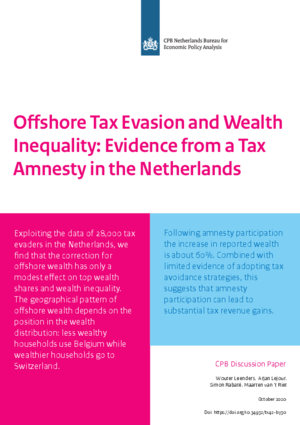Offshore Tax Evasion and Wealth Inequality: Evidence from a Tax Amnesty in the Netherlands
We use unique microdata to study tax evasion in the Netherlands. We have received data on over 27,000 participants to the Dutch tax amnesty between the years 2002 and 2018. In addition, we have data on households who appeared in recent information requests to 4 different Swiss banks. We link these data to administrative data on income, wealth, and demographics covering the entire Dutch population.
Downloads
We provide two sets of results. First, we provide a new estimate of the wealth distribution in the Netherlands by correcting for wealth hidden offshore, as done by Alstadsæter, Johannesen and Zucman (2019) for Scandinavian countries. While evasion is concentrated at the top, the correction for hidden offshore wealth is small. This can be explained by the fact that the richest households own a relatively small share of wealth declared through the amnesty: the top 0.01% owns 7% of amnesty wealth, compared to 48% in the case of Norway. The hidden wealth discovered through the information request to Swiss banks is even less concentrated.
We show that the distribution pattern of tax evasion depends on the type of tax evasion. By distinguishing offshore wealth in Belgium, Luxembourg and Switzerland, we find that concentration of tax evasion is increasing in geographical and cultural distance: over two thirds of Belgium wealth declared through the amnesty is held by the bottom 99%. For Luxembourg and Switzerland, this is only 38% and 23%, respectively.
Second, we investigate whether the voluntary compliance through participation in the amnesty increases tax revenues in the longer term. Like Alstadsæter, Johannesen and Zucman (2018), we find a strong and sustainable effect on declared wealth with evidence of only a moderate substitution towards avoidance techniques in later years. This implies that the increase in compliance through the amnesty program leads to a structural increase in tax revenues. The increase in compliance is strongly related to changes in the penalty rate: amnesty participation peaks each time the penalty rate increases, in particular when it increases from 0%.
Authors



